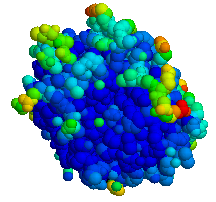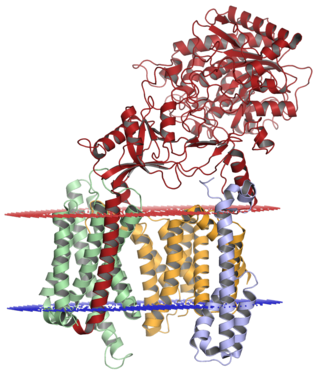Related Research Articles

Proteolysis is the breakdown of proteins into smaller polypeptides or amino acids. Uncatalysed, the hydrolysis of peptide bonds is extremely slow, taking hundreds of years. Proteolysis is typically catalysed by cellular enzymes called proteases, but may also occur by intra-molecular digestion.

A protease is an enzyme that catalyzes proteolysis, breaking down proteins into smaller polypeptides or single amino acids, and spurring the formation of new protein products. They do this by cleaving the peptide bonds within proteins by hydrolysis, a reaction where water breaks bonds. Proteases are involved in numerous biological pathways, including digestion of ingested proteins, protein catabolism, and cell signaling.

In molecular biology, elastase is an enzyme from the class of proteases (peptidases) that break down proteins. In particular, it is a serine protease.

Serine proteases are enzymes that cleave peptide bonds in proteins. Serine serves as the nucleophilic amino acid at the (enzyme's) active site. They are found ubiquitously in both eukaryotes and prokaryotes. Serine proteases fall into two broad categories based on their structure: chymotrypsin-like (trypsin-like) or subtilisin-like.

Gamma secretase is a multi-subunit protease complex, itself an integral membrane protein, that cleaves single-pass transmembrane proteins at residues within the transmembrane domain. Proteases of this type are known as intramembrane proteases. The most well-known substrate of gamma secretase is amyloid precursor protein, a large integral membrane protein that, when cleaved by both gamma and beta secretase, produces a short 37-43 amino acid peptide called amyloid beta whose abnormally folded fibrillar form is the primary component of amyloid plaques found in the brains of Alzheimer's disease patients. Gamma secretase is also critical in the related processing of several other type I integral membrane proteins, such as Notch, ErbB4, E-cadherin, N-cadherin, ephrin-B2, or CD44.

Presenilins are a family of related multi-pass transmembrane proteins which constitute the catalytic subunits of the gamma-secretase intramembrane protease protein complex. They were first identified in screens for mutations causing early onset forms of familial Alzheimer's disease by Peter St George-Hyslop. Vertebrates have two presenilin genes, called PSEN1 that codes for presenilin 1 (PS-1) and PSEN2 that codes for presenilin 2 (PS-2). Both genes show conservation between species, with little difference between rat and human presenilins. The nematode worm C. elegans has two genes that resemble the presenilins and appear to be functionally similar, sel-12 and hop-1.

Aspartic proteases are a catalytic type of protease enzymes that use an activated water molecule bound to one or more aspartate residues for catalysis of their peptide substrates. In general, they have two highly conserved aspartates in the active site and are optimally active at acidic pH. Nearly all known aspartyl proteases are inhibited by pepstatin.

Caspase-6 is an enzyme that in humans is encoded by the CASP6 gene. CASP6 orthologs have been identified in numerous mammals for which complete genome data are available. Unique orthologs are also present in birds, lizards, lissamphibians, and teleosts. Caspase-6 has known functions in apoptosis, early immune response and neurodegeneration in Huntington's and Alzheimer's disease.
Membrane-bound transcription factor site-2 protease, also known as S2P endopeptidase or site-2 protease (S2P), is an enzyme encoded by the MBTPS2 gene which liberates the N-terminal fragment of sterol regulatory element-binding protein (SREBP) transcription factors from membranes. S2P cleaves the transmembrane domain of SREPB, making it a member of the class of intramembrane proteases.

Minor histocompatibility antigen H13 is a protein that in humans is encoded by the HM13 gene.

Signal peptide peptidase 3, also known as UNQ1887, is a human gene.

Signal peptide peptidase-like 2B, also known as SPPL2B, is a human gene.

Signal peptide peptidase-like 2A, also known as SPPL2A, is a human gene.

Presenilins-associated rhomboid-like protein, mitochondrial (PSARL), also known as PINK1/PGAM5-associated rhomboid-like protease (PARL), is an inner mitochondrial membrane protein that in humans is encoded by the PARL gene on chromosome 3. It is a member of the rhomboid family of intramembrane serine proteases. This protein is involved in signal transduction and apoptosis, as well as neurodegenerative diseases and type 2 diabetes.

ATP-dependent Clp protease proteolytic subunit (ClpP) is an enzyme that in humans is encoded by the CLPP gene. This protein is an essential component to form the protein complex of Clp protease.

The rhomboid proteases are a family of enzymes that exist in almost all species. They are proteases: they cut the polypeptide chain of other proteins. This proteolytic cleavage is irreversible in cells, and an important type of cellular regulation. Although proteases are one of the earliest and best studied class of enzyme, rhomboids belong to a much more recently discovered type: the intramembrane proteases. What is unique about intramembrane proteases is that their active sites are buried in the lipid bilayer of cell membranes, and they cleave other transmembrane proteins within their transmembrane domains. About 30% of all proteins have transmembrane domains, and their regulated processing often has major biological consequences. Accordingly, rhomboids regulate many important cellular processes, and may be involved in a wide range of human diseases.
Intramembrane proteases (IMPs), also known as intramembrane-cleaving proteases (I-CLiPs), are enzymes that have the property of cleaving transmembrane domains of integral membrane proteins. All known intramembrane proteases are themselves integral membrane proteins with multiple transmembrane domains, and they have their active sites buried within the lipid bilayer of cellular membranes. Intramembrane proteases are responsible for proteolytic cleavage in the cell signaling process known as regulated intramembrane proteolysis (RIP).
Signal peptidase I is an enzyme. This enzyme catalyses the following chemical reaction
Prepilin peptidase is an enzyme found in Type IV filament systems responsible for the maturation of the pilin. This enzyme catalyses the following chemical reaction
Asparagine peptide lyase are one of the seven groups in which proteases, also termed proteolytic enzymes, peptidases, or proteinases, are classified according to their catalytic residue. The catalytic mechanism of the asparagine peptide lyases involves an asparagine residue acting as nucleophile to perform a nucleophilic elimination reaction, rather than hydrolysis, to catalyse the breaking of a peptide bond.
References
- ↑ Weihofen A, Binns K, Lemberg MK, Ashman K, Martoglio B (2002). "Identification of signal peptide peptidase, a presenilin-type aspartic protease". Science. 296 (5576): 2215–8. Bibcode:2002Sci...296.2215W. doi:10.1126/science.1070925. PMID 12077416. S2CID 45633906.
- ↑ Martoglio B, Golde TE (October 2003). "Intramembrane-cleaving aspartic proteases and disease: presenilins, signal peptide peptidase and their homologs". Hum. Mol. Genet. 12 Spec No 2: R201-6. doi: 10.1093/hmg/ddg303 . hdl: 20.500.11850/53541 . PMID 12966028.
- ↑ Lemberg MK, Bland FA, Weihofen A, Braud VM, Martoglio B (2001). "Intramembrane proteolysis of signal peptides: an essential step in the generation of HLA-E epitopes". J. Immunol. 167 (11): 6441–6. doi: 10.4049/jimmunol.167.11.6441 . PMID 11714810.
- ↑ Okamoto K, Mori Y, Komoda Y, Okamoto T, Okochi M, Takeda M, Suzuki T, Moriishi K, Matsuura Y (2008). "Intramembrane processing by signal peptide peptidase regulates the membrane localization of hepatitis C virus core protein and viral propagation". J. Virol. 82 (17): 8349–61. doi:10.1128/JVI.00306-08. PMC 2519675 . PMID 18562515.
- ↑ Snell GD, Cudkowicz G, Bunker HP (Jun 1967). "Histocompatibility genes of mice. VII. H-13, a new histocompatibility locus in the fifth linkage group". Transplantation. 5 (3): 492–503. doi:10.1097/00007890-196705000-00011. PMID 5340356. S2CID 31345625.
- ↑ "Entrez Gene: H13 histocompatibility (minor) 13".
- ↑ Friedmann E, Hauben E, Maylandt K, et al. (2006). "SPPL2a and SPPL2b promote intramembrane proteolysis of TNFα in activated dendritic cells to trigger IL-12 production". Nat. Cell Biol. 8 (8): 843–8. doi:10.1038/ncb1440. PMID 16829952. S2CID 129089.
- ↑ Fluhrer R, Grammer G, Israel L, et al. (2006). "A gamma-secretase-like intramembrane cleavage of TNFalpha by the GxGD aspartyl protease SPPL2b". Nat. Cell Biol. 8 (8): 894–6. doi:10.1038/ncb1450. PMID 16829951. S2CID 23712486.
- ↑ Narayanan S, Sato T, Wolfe MS (July 2007). "A C-terminal region of signal peptide peptidase defines a functional domain for intramembrane aspartic protease catalysis". J. Biol. Chem. 282 (28): 20172–9. doi: 10.1074/jbc.M701536200 . PMID 17517891.
- ↑ Lory S, Strom MS (June 1997). "Structure-function relationship of type-IV prepilin peptidase of Pseudomonas aeruginosa--a review". Gene. 192 (1): 117–21. doi:10.1016/S0378-1119(96)00830-X. PMID 9224881.